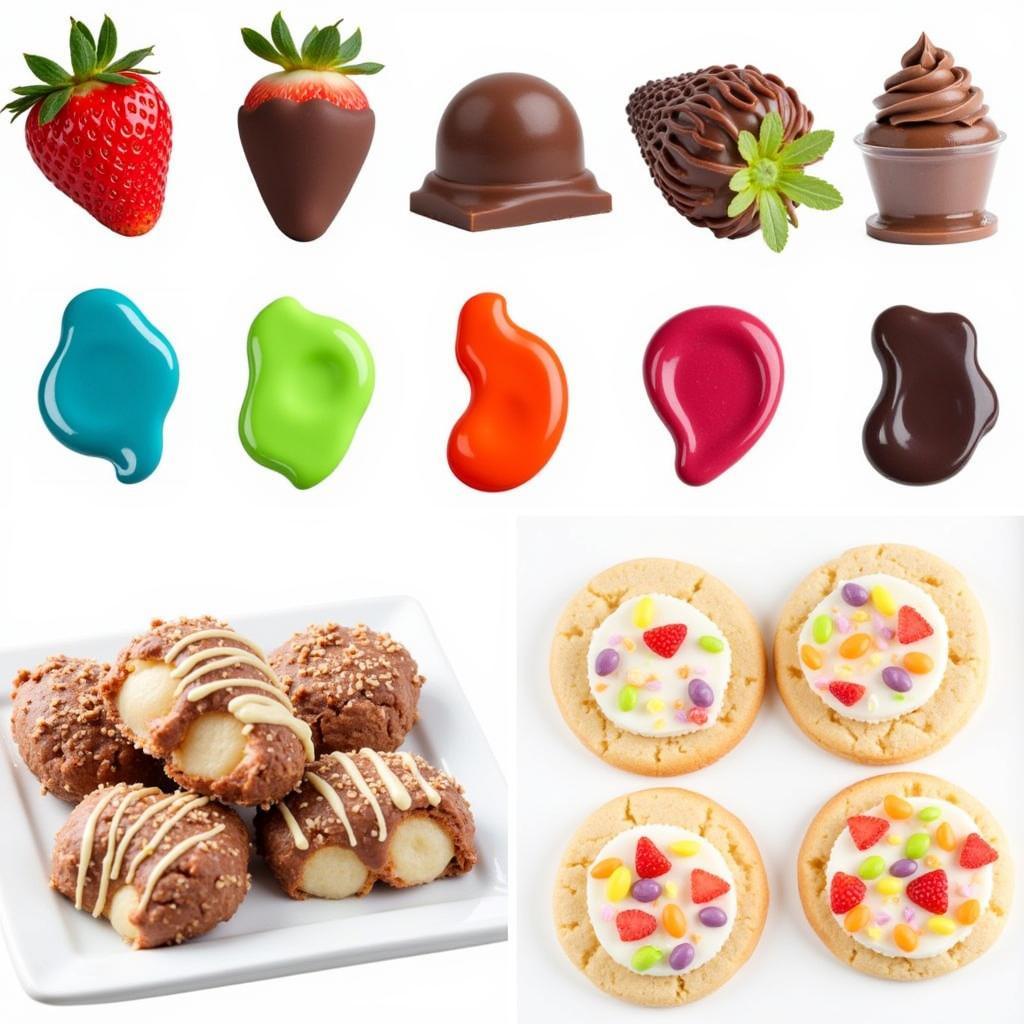Can you add food coloring to chocolate melts? The short answer is: it’s complicated. While you might be tempted to use regular food coloring, it won’t work with chocolate melts due to their unique composition. Let’s dive into the details and discover the best ways to achieve vibrant colors in your chocolate creations.
Understanding Chocolate Melts and Food Coloring
Chocolate melts, often called candy melts or confectionery coating, are a convenient alternative to real chocolate for dipping, molding, and decorating. They are typically made with vegetable oil instead of cocoa butter, giving them a lower melting point and a smoother consistency. This difference in composition is key to understanding why regular water-based food coloring doesn’t mix well with chocolate melts. Adding water-based coloring to chocolate melts will cause them to seize, becoming thick and unusable. Is gel food coloring oil based? You can learn more in another article.
Why Regular Food Coloring Doesn’t Work
Water and oil don’t mix, and the same principle applies to water-based food coloring and oil-based chocolate melts. The water in the food coloring creates an emulsion, causing the chocolate to seize up and become grainy. This is why you need a special type of food coloring designed specifically for chocolate. Can you color almond bark with food coloring? Similar principles apply here, as almond bark also contains oils.
The Right Way to Color Chocolate Melts
So, what’s the solution? Oil-based food coloring is your best bet for achieving vibrant and consistent colors in chocolate melts. These colorings are specifically formulated to blend seamlessly with oil-based products. You can find oil-based food coloring in specialty baking stores or online. Another option is to use powdered candy colors, which are also oil-based and disperse easily in melted chocolate.
Using Oil-Based Food Coloring
- Start with white chocolate melts: White chocolate provides a blank canvas for achieving bright, true-to-hue colors.
- Melt the chocolate: Follow the package instructions for melting the chocolate melts.
- Add the coloring: Add the oil-based food coloring drop by drop, stirring constantly until the desired color is reached. Remember, a little goes a long way!
- Test the color: Dip a small item, like a pretzel or a piece of fruit, into the colored chocolate to test the shade before dipping or molding larger items. Can i add food coloring to almond bark? Yes, and the same method applies using oil-based coloring.
 Colored Chocolate Creations
Colored Chocolate Creations
“When working with oil-based colors,” advises pastry chef Emily Carter, “remember that they can be very concentrated. Start with a small amount and gradually add more until you achieve the desired shade. This will prevent you from over-coloring your chocolate.”
Troubleshooting Common Coloring Issues
Sometimes, even with oil-based coloring, you might encounter issues. Here are a few common problems and solutions:
- Streaky or uneven color: This can happen if the coloring isn’t fully incorporated. Make sure to stir thoroughly after each addition of coloring.
- Dull colors: If your colors aren’t as vibrant as you’d like, try adding more coloring, a drop at a time.
- Seized chocolate: If your chocolate becomes thick and grainy, it’s likely due to moisture. This can happen if your utensils or bowls are not completely dry. Discard the seized chocolate and start again with dry equipment. Is wilton color right oil based? You might want to check that out if you are using Wilton products.
“Another tip,” adds Chef Carter, “is to use high-quality white chocolate melts. The better the quality of the base, the better the color payoff will be.” How to make hot pink using food coloring can offer some helpful insights for achieving specific shades.
Conclusion
Can you add food coloring to chocolate melts? Yes, but only with the right type of food coloring. By using oil-based food coloring or powdered candy colors, you can unlock a world of vibrant possibilities for your chocolate creations. Remember to start with small amounts of coloring and stir thoroughly for even distribution. With a little practice, you’ll be creating stunning and delicious treats in no time.
FAQs
- Can I use liquid food coloring in chocolate melts? No, liquid food coloring is water-based and will cause the chocolate to seize.
- Where can I buy oil-based food coloring? Specialty baking stores, craft stores, and online retailers often carry oil-based food coloring.
- How much oil-based food coloring should I use? Start with a small amount, a drop or two, and add more as needed until you reach the desired color.
- What should I do if my chocolate melts seize? Discard the seized chocolate and start again with dry equipment and fresh chocolate melts.
- Can I mix different colors of oil-based food coloring? Yes, you can mix different colors to create custom shades.
- Can I use gel food coloring in chocolate melts? No, most gel food colorings are water-based and will cause the chocolate to seize.
- What is the best type of chocolate to use for coloring? White chocolate melts provide the best base for achieving vibrant colors.
Contact Us
For any assistance, feel free to contact us:
Phone: 0373298888
Email: [email protected]
Address: 86 Cau Giay, Hanoi.
We have a 24/7 customer support team.